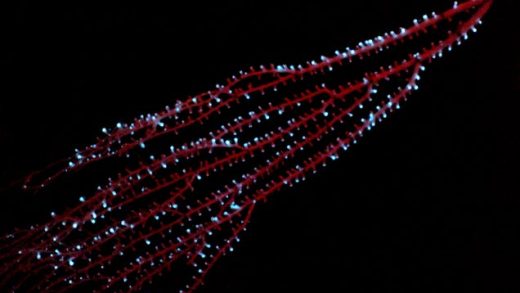One of my more heavily annotated books is Travels With Charley by John Steinbeck. Though the book is billed as a travelog, it’s clear that Steinbeck made a great deal of it up, and he certainly ignored the advice of John McPhee, writing in The New Yorker more than 50 years after Steinbeck’s trip, on how nonfiction writers should report back the conversations they’ve had along the way: “Please understand: you trim and straighten […] but you do not make it up.” Regardless, many of the interactions Steinbeck reports have enduring verisimilitude.
It’s early morning in Maine and Charley, Steinbeck’s much-anthropomorphized dog, has been walked. Steinbeck lets us know that he’s not normally a breakfast eater, but “here I had to be or I wouldn’t see anybody unless I stopped for gas.” He pulls in to a roadside restaurant. Inside, the only conversations he finds are stilted, monosyllabic interactions about coffee refills between the waitress and her customers. These customers, he says, are “folded over their coffee cups like ferns.” He tries to chat but, much to his chagrin, is largely ignored.
To Steinbeck, the coffee drinkers appear lonesome, burdened, inward. When I first read Travels with Charley back in 2012, I underlined this botanical simile in part because I loved the description but mostly because I thought Steinbeck had missed the point. I wanted to defend the actions of these customers. These people were choosing to get lost in their coffees. Theirs was a willed effort to curl up in their own little worlds, to the exclusion of others, for a brief, defined interlude. Steinbeck, not the customers, is the negative, toiled energy here: he’s an irritant, a man with a dog trying to upset the balance and clatter away that moment like an alarm clock in the morning. I only realized why I felt this way so strongly when I sat down in front of the television a few weeks ago.
*
I’d first watched, and loved, the original two seasons of Twin Peaks more than 10 years prior. Formative, slightly creepy, culty television with a blurry mix of great (and woeful) dialogue, visionary (and ultimately unworkable) plot-making and strong (and goddamn terrible) acting, it would be an antidote to watching our real world slowly burning; instead we’d be able to zoom in on a small community where the problems were tangibly immediate—murders, and really odd ones at that.
Coffee, as those who have watched the show will not have failed to notice, is a rather important part of Twin Peaks. Writing for Paste, Hannah Sentenac identified no fewer than 70 spoken references to coffee in the first two seasons aired in the early nineties.
In the second episode of season one, FBI Special Agent Dale Cooper, who has recently arrived in the town of Twin Peaks to lead the investigation into the murder of Laura Palmer, has breakfast in the town’s only hotel, the Great Northern. He stands his Dictaphone upright on the table next to his knife. Coffee is poured for him from a red-handled carafe by a waitress into a small, white cup and the camera pans to his face as he looks down excitedly and expectantly. He asks the waitress to wait; he sniffs, sips and smiles and then in reverie utters that oft-quoted line: “This is—excuse me—a damn fine cup of coffee.” He continues, “I’ve had I don’t know how many cups of coffee in my life, but this is one of the best.”
It was upon re-watching this scene that I had my moment of perspicacity about Travels with Charley. This was the scene that shaped the way I drink—and think—coffee: the urtext for my coffee habits, the reason why I underlined that Steinbeck quote. I’ll explain.
Cooper is alone. He is in a dining room (full wood décor—this is a timber town after all) packed with people, some with fishing rods in hand and some smartly dressed in suits reading serious newspapers. He’s no doubt been in dining rooms like this, with people like this, but he’s never quite been here before. He sits with a new, localized adventure before him, like a man about to board a ship or a train back in the days when that meant something bigger. This coffee moment is like the pull-off on a scenic road, connected like a thread to everything before and everything that will come, an opportunity to step out momentarily and look over before you journey on.
The second part of the equation is the coffee itself. Others before me have written about the apparent excellence of the coffee served in Twin Peaks. In a 2017 essay for Eater, Melissa Buote tries to determine the exact kind of coffee that Cooper likes, investigating which coffee brands were most commonly available in the Pacific Northwest in the eighties and nineties. She ultimately concludes that all this didn’t really matter, because for Cooper, “it’s about the experience. It’s an encounter. It’s simply being present […] not about the coffee at all.” I agree: excepting a single instance where the coffee percolator has (inexplicably) been infiltrated by a fish, Cooper loves the local coffee, whatever it is, wherever it’s brewed.
If it isn’t really about the taste, then what is it about?
In season two, Cooper, Harry (the Twin Peaks sheriff) and Albert (a fellow FBI agent and, in pointed contrast to Cooper, an intentionally insulting, brusque newcomer to the Pacific Northwest) are in the hospital conducting interviews after a terrible night for a disproportionately large number of the residents of Twin Peaks. Waiting for a condition update on one of the afflicted, they drink hospital coffee. After multiple slapstick scenes about the revolting hospital food, Cooper and Harry are still shown to be enjoying the hospital coffee. Albert, however, is disgusted by it. Sour mind; bitter coffee.
Cooper’s philosophy is quite the opposite. He’s hoping for the best, willing for the toast to land butter-side up. He wants not just coffee but a coffee. In that breakfast scene at the Great Northern Hotel, he hasn’t even taken his first sip of coffee when he asks the waitress to linger so that he can praise her. His is a philosophy of hope. Albert might be as lumbering as Steinbeck on a Maine morning but Cooper can nimbly adapt to the flavors of a lumber town.
Coffee à la Cooper: an interlude made by a simple cup of joe and a mind filled with hope, curled up within itself.
*
 At one point in Shirley Jackson’s 1959 novel The Haunting of Hill House the protagonist, Eleanor, overhears in a country restaurant a young girl calling for her “cup of stars.” The girl’s mother explains to the waitress that she can only enjoy milk from her special cup which has stars printed on the inside. Eleanor admires this juvenile resoluteness and implores the child to stick to her guns.
At one point in Shirley Jackson’s 1959 novel The Haunting of Hill House the protagonist, Eleanor, overhears in a country restaurant a young girl calling for her “cup of stars.” The girl’s mother explains to the waitress that she can only enjoy milk from her special cup which has stars printed on the inside. Eleanor admires this juvenile resoluteness and implores the child to stick to her guns.
In his more indiscriminate approach to coffee-drinking, Cooper represents the contrary position: it’s not at all about the single cup, but more about this replicable liquid—which is, in Cooper’s own wonderfully poetic words, as “black as midnight on a moonless night.” No stars required.
Coffee à la Cooper can be achieved almost anywhere—when out walking in the Douglas Firs or sat on the subway, for example. The coffee itself doesn’t really matter. A quotidian refill for life away from the grind. It’s a highly affordable, replicable, and achievable set of conditions.
A couple of years after I first watched Twin Peaks I moved to New York. On that first night in my new home city, I walked into a diner one block away from my new apartment and saw two oversized coffee pots heating a treacly black liquid. A lopsided, handwritten sign propped against the wall on the counter proudly announced the humble cost of trying this offering: $1.00. I sat down, ordered a cup from the waitress, and looked at the faces around me. Some were looking at each other and talking and some were buried in a book or staring at the large television over on the windowless wall. It arrived in mere moments; I took a small sip and let the burned, tarry taste infuse my body. It was fine. I was there and then anew.
The post Coffee à la Cooper appeared first on The Millions.
Source : Coffee à la Cooper













